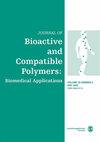Effect of pH on salicylic acid-based poly(anhydride-ester): Implications for polymer degradation and controlled salicylic acid release
IF 2.1
4区 生物学
Q3 BIOTECHNOLOGY & APPLIED MICROBIOLOGY
引用次数: 2
Abstract
Salicylic acid (SA)-based poly(anhydride-esters) (SAPAEs) hydrolytically degrade to release SA in a controlled manner over extended time periods. While these polymers have been well investigated under in vivo conditions, this study is the first detailed, systematic assessment of in vitro polymer degradation over a range of pH values. To investigate the effect of pH conditions on SAPAE degradation, in vitro degradation studies were conducted on SAPAE disks over a wide pH range (2.0, 4.0, 6.0, 7.4, 8.0, 9.0, and 10.0) for 30 days. Several parameters were evaluated, including SA concentrations in the degradation media, polymer mass loss, water uptake in the polymer matrices, and SA solubility at different pH values to substantiate SA release results and characterize the in vitro polymer degradation process. Complete SA release was achieved at more basic conditions (pH 9.0 and 10.0) over 9 days, whereas less than 41% SA was released over the same time period at neutral pH conditions (pH 8.0 and 7.4). By comparison, SA release was minimal in acidic pH conditions. Overall, we present quantitative data of polymer degradation as defined by SA in vitro release, which increased with increasing pH values. More basic conditions promoted polymer degradation, whereas acidic conditions minimized polymer degradation.pH对水杨酸基聚酸酐酯的影响:对聚合物降解和控制水杨酸释放的影响
水杨酸(SA)为基础的聚酸酐酯(sapae)水解降解释放SA在一段时间内可控的方式。虽然这些聚合物已经在体内条件下进行了很好的研究,但本研究是第一次详细、系统地评估体外聚合物在一定pH值范围内的降解。为了研究pH条件对SAPAE降解的影响,我们在较宽的pH范围(2.0、4.0、6.0、7.4、8.0、9.0和10.0)下对SAPAE圆盘进行了30天的体外降解研究。研究评估了几个参数,包括降解介质中的SA浓度、聚合物质量损失、聚合物基质中的吸水率和不同pH值下SA的溶解度,以证实SA释放结果并表征体外聚合物降解过程。在碱性条件(pH 9.0和10.0)下,SA在9天内完全释放,而在中性pH条件(pH 8.0和7.4)下,SA在相同时间内的释放量不到41%。相比之下,SA在酸性pH条件下释放最少。总的来说,我们给出了聚合物降解的定量数据,即SA体外释放,随着pH值的增加而增加。更基本的条件促进聚合物降解,而酸性条件最小化聚合物降解。
本文章由计算机程序翻译,如有差异,请以英文原文为准。
求助全文
约1分钟内获得全文
求助全文
来源期刊

Journal of Bioactive and Compatible Polymers
工程技术-材料科学:生物材料
CiteScore
3.50
自引率
0.00%
发文量
27
审稿时长
2 months
期刊介绍:
The use and importance of biomedical polymers, especially in pharmacology, is growing rapidly. The Journal of Bioactive and Compatible Polymers is a fully peer-reviewed scholarly journal that provides biomedical polymer scientists and researchers with new information on important advances in this field. Examples of specific areas of interest to the journal include: polymeric drugs and drug design; polymeric functionalization and structures related to biological activity or compatibility; natural polymer modification to achieve specific biological activity or compatibility; enzyme modelling by polymers; membranes for biological use; liposome stabilization and cell modeling. This journal is a member of the Committee on Publication Ethics (COPE).
 求助内容:
求助内容: 应助结果提醒方式:
应助结果提醒方式:


